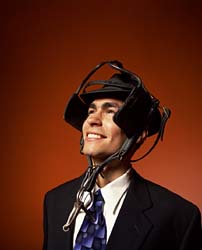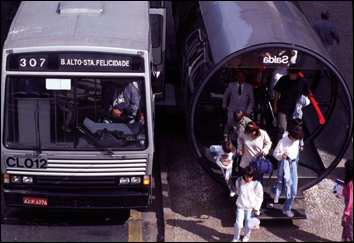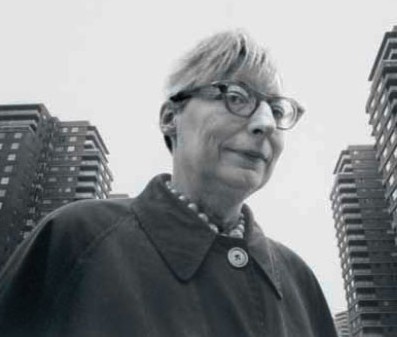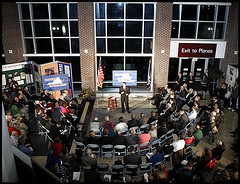Choke points

 A person and a horse with blinders, respectively. Photos from PictureQuest and Seattle Lighthouse for the Blind.
A person and a horse with blinders, respectively. Photos from PictureQuest and Seattle Lighthouse for the Blind.Earlier in the week, the Sprawl and Crawl columnist in the Examiner commented on the brillance of WMATA's proposal to increase the number of cars in a subway train, but reduce the overall number of trains, in order to prevent trains from having to stop in the tunnel from Rosslyn to DC. (This idea was suggested by an APTA peer review team.)
I think of this as not counter-intuitive thinking, but of quality thinking generally.
Jaime Lerner, at the time the Mayor of Curitiba, which is the Brazilian city that has pioneered Bus Rapid Transit, was faced with a dilemma. The buses weren't moving as fast as they needed to, and they couldn't afford to create a faster, underground subway, because of the expense.
So he took a folding chair and sat next to the bus stop in front of City Hall for a week, and observed. He realized that the delays came from the boarding process, and if people could just get on and off fast, once the bus stopped, that delays would be negligible.
 BBC photo of a Curitiba bus rapid transit entryway.
BBC photo of a Curitiba bus rapid transit entryway.So they created the dedicated entry system, comparable to that of underground subway systems, but with surface transit service. This online article describes Lerner's thinking:
"While other cities thought about a subway for the year 2000, we wanted a good public transport system now." The result was five special multi-avenue channels radiating out from the city center, much like the spokes on a wheel, with special avenues for fast limited-stop buses and parallel avenues for slower local buses. Other local bus routes link the five spokes. The system has gradually evolved into a marvel of efficiency.
The key to the fast lanes is special large plastic tubes at the bus stops. Passengers pay their fare upon entering the tube, not boarding the bus. The other end of the tube interlocks with special wide bus doors allowing eight people to enter or exit the bus per second. Add to this special three-coach linked buses that hold 270 people, and Curitiba's high-speed buses move more people than a subway system, just as quickly, but at a fraction of the cost of a subway. City officials from around the world, including New York, Vancouver, and Lyon, have come to Curitiba to take a look.
The system works so well that even Curitibanos who have cars prefer to use the bus system. Curitiba has the second highest number of cars per capita in Brazil - one for every three inhabitants, but the lowest use of autofuel per capita among Brazilian cities. And in Curitiba, traffic jams are almost unheard of.
Similarly, I keep making the point that one of the best ways to deal with daytime road congestion is to shift business deliveries and truck traffic as much as possible to early morning and evening hours, when the roads, at least in Washington, DC, are practically deserted by comparison to the times during "business hours." (Some establishments, such as the Au Bon Pain restaurant chain, already do this.)
Or, a choke point is how people think they need to be served by retail, such as the previous entry, which points out that different ways of providing grocery stores make it possible to serve urban settings with quality retail, and in a way that promotes the development of independent businesses.
Or Gordon Brown's suggestion, not adopted, that when the city contracted out recycling pick up services, they made one big contract, and of course, only the biggest companies, like Waste Management, could handle it. But had they broken up the contract into 3 or 4 pieces, say by quadrant, smaller businesses could have competed on a more equal footing. And local business capacity and capability could have been nurtured and strengthened.
 For the record, because of the network effects, I use Windows, but as the inventor of the ctrl-alt-delete sequence said, "I invented it, but Bill [Gates] made it famous..."
For the record, because of the network effects, I use Windows, but as the inventor of the ctrl-alt-delete sequence said, "I invented it, but Bill [Gates] made it famous..."Still, it's not easy to "think different," because organizations aren't looking for excellence, as pointed out in this interview with Robert Quinn, entitled "Change: It's a Matter of Life or Slow Death."
I mean, who would have "thunk" that Michael Brown, the now discredited ex-FEMA director, actually was communicating to the Dept. of Homeland Security that the changes they were instituting were destroying the effectiveness of the agency, according to today's Post article, "Brown's Turf Wars Sapped FEMA's Strength: Director Who Came to Symbolize Incompetence in Katrina Predicted Agency Would Fail."
 Jane Jacobs.
Jane Jacobs. Of course, this gets back to a point made by Jane Jacobs a long time ago, paraphrased something like this: "People who ask why the roads are congested are asking the wrong question. The right question is 'why are there so many cars'" which is a message that needs to be communicated to officials in Fairfax County, at least according to the way I read this article, "A Strategy to Ease Congestion Amid Challenges of Growth," from last week's Fairfax Extra.
 Gov.-elect Timothy M. Kaine at a town meeting last month at Manassas Regional Airport. Board of Supervisors Chairman Gerald E. Connolly and Del. James M. Scott urged Kaine to create an office of congestion management. (By Joel Richardson -- The Washington Post)
Gov.-elect Timothy M. Kaine at a town meeting last month at Manassas Regional Airport. Board of Supervisors Chairman Gerald E. Connolly and Del. James M. Scott urged Kaine to create an office of congestion management. (By Joel Richardson -- The Washington Post)Index Keywords: transit; change-management



0 Comments:
Post a Comment
<< Home